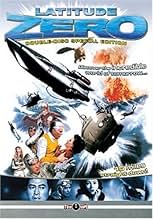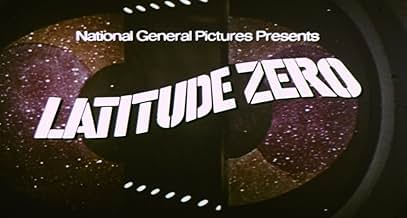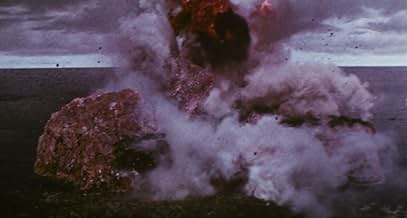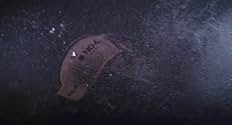Aggiungi una trama nella tua linguaA journalist is saved by a giant submarine captained by a 200-year-old man who takes him to an underwater paradise city where no one ages. That's when monsters and mutants sent by the captai... Leggi tuttoA journalist is saved by a giant submarine captained by a 200-year-old man who takes him to an underwater paradise city where no one ages. That's when monsters and mutants sent by the captain's rival, a 200-year-old scientist, attack.A journalist is saved by a giant submarine captained by a 200-year-old man who takes him to an underwater paradise city where no one ages. That's when monsters and mutants sent by the captain's rival, a 200-year-old scientist, attack.
- Regia
- Sceneggiatura
- Star
Recensioni in evidenza
Joseph Cotton ("Citizen Kane"), Cesar Romero (TV "Batman's" original Joker) and Richard Jaeckel ("The Dirty Dozen", "Spenser:For Hire", "The Green Slime"), were another three who appeared in this offbeat blend of sci-fi and fantasy.
Cotten has his hands full as a Captain Nemo-esque commander of the super sub Alpha (an odd coincidence, since he later played the famous submariner in MGM's "Captain Nemo and the Underwater City"), fighting against a mad scientist (Romero) with a penchant for splicing together mutant creatures to rule the world. Jaeckel plays the reporter tossed into this crazy conflict, which has little or no plot or character development, but is just your average no-brainer popcorn flick perfect for the fanboy in all of us.
A strange twist was the marketing of this film as a sequel to the live action version of the anime movie "Atragon", another super sub movie that bears absolutely no resemblance in design or plot to "Latitude Zero".
My favourite Japanese/American co-production ever made!
Those early scenes of Latitude Zero are very Voyage to the Bottom of the Sea-ish, in fact I almost felt like I discovered some long lost Irwin Allen production when recently viewing Latitude Zero for my first time!
The colourful lines given to Cotten and Romero are what stand out in my memory more than anything else. But the blinking light computer hardware and energetic musical score are stand outs. The land sets at the end are very impressive.
Please note, the later sections of the movie turn into this oddball horror show with a surgical operation like no other seen in the history of film. At one point I had to turn away from the screen.
The is a highly underrated movie and a nice mix of Japanese and American film making. For all fans of the 1966 Adam West Batman series as this is basically Romero doing The Joker without white make up.
Story: 1.25 Direction: 1.25 Pace: 1.25 Acting: 1.25 Enjoyment: 1.25
TOTAL: 6.25 out of 10.00
I don't know which movie came out first, as both got released in 1969, but the similarities between Latitude Zero and Captain Nemo and the Underwater City are astounding. Though I will admit, I prefer the more fantastical Latitude Zero.
One reason is the script. The writers give the audience more plot, extra intrigue, and additional science fiction elements. When the story begins, we watch a bathysphere containing two researchers and a journalist get lowered into the ocean to study the Cromwell Current. But an underwater volcano has other plans for our intrepid trio when it erupts and tears the sphere away from its tether. Luckily for the threesome, a high-tech submarine is in the area, and Captain McKenzie dispatches divers to save them. But the waters don't run calm for our accidental tourists as McKenzie subs them to his submerged Utopian city. Unfortunately, the mad doctor Malic spots the Alpha on his radar and dispatches his attack sub, the Black Shark, to intercept. But thanks to Captain Mckenzie's and his second in command's skills, they reach the safely of the city. Once in the metropolis, their eyes behold wonders that stagger their minds. The overabundance of diamonds grabs the greedy attention of reporter Perry Lawton. While the two scientists are interested in the technological advancements that Latitude Zero possesses. Though the question is, will our human-weary Captain give our three explorers the chance to go topside? And, what has Dr Malic got in mind for the good Captain and his underwater haven? The one element of the story that could have been more robust is the individual's characteristics. For example, the Captain is a stoic and steadfast man whose opinions are tough to change. Yet, his traits aren't as strong as his ideals; his personality needed to be tough and less of a playful pussycat in his dandy apparel. And the two scientists needed more substance to their personalities. But as an adventure story goes, it's not too shabby.
Where Latitude Zero excels over the Hollywood flick is the imaginative use of special effects. Director Ishero Honda has a superb eye for detail, and the SFX interweave beautifully with the live-action sections. There's a lot of modelling work; this is on par with Gerry Anderson's Thunderbirds and has a similar style. One scene stood out to me most. When the Captain docks the Alpha, you see the model submarine moored against the harbour wall, and in front of them is a real ambulance and performers. This mixing of two distinct media types was tricky to pull off credibly in the 60s. And though the scene is only a few seconds long, the effect is flawless. The worst creations are the mutated flying bat-people. They're not scary, not in the slightest - you only want to set them free to fly away. It's also funny that Malic engineered this Bat-Man and Bat-Woman because Cesar Romero plays Malic - think about it - The Joker Made Bat-Man and Bat-Woman! However, I did love the flying lion. This pussy cat really can bank and dive. I was waiting for him to complete a loop-de-loop or a victory roll. The best came when he landed and began his growling attack. You can tell it's a bloke in a costume, but the garb is that good, and the bloke's actions aren't too terrible that the outrageous scene actually works - I loved it. Honda keeps everything bright and colourful throughout all the onscreen mayhem and inventiveness. For the most part, he uses a standard filming style but will slip in one or two gems, like the montage of the city, we see both genuine and model buildings, and then we zoom out and see we're looking at a model of the metropolis, as we then pan to our heroes and the Captain. His pacing of the movie keeps the storytelling at an agreeable tempo.
The actors aren't the best thing about the movie. In fact, I only chose to watch the picture because Richard Jaeckel and Cesar Romero stared. And these two actors are the best in their portrayals. Romero is ideal as the mad-scientist Malic - and his performance isn't that reminiscent of The Joker. His insanity is more sedate and a little scarier. And, Jaeckel does a decent job at portraying the reporter Lawton. He adds a smug kindness to his character that works well. Patricia Medina, who plays Malic's other half, Lucretia, surprised me. She was strong, sexy, and a woman you wouldn't want to get on the wrong side of - good thing her bo was mad.
Everything considered I would joyfully recommend Latitude Zero to anybody looking for a movie to put a smile on their face. And if you're a Sci-Fi B-Movie fan and have yet to watch LZ, run and find a copy as this is a film you guys and galls shouldn't miss.
Shoot that darned flying lion, then take a look at my IMDb list - The Final Frontier to see where I ranked Latitude Zero.
Take Care & Stay Well.
Lo sapevi?
- QuizLucretia, the evil Malic's companion, was played by 'Patricia Medina'. At the time this was filmed, she was married to Joseph Cotten who was playing good guy Captain Craig McKenzie.
- BlooperThe bat creatures' arms are connected to their wings. However in some shots (usually the ones require them to pick up or push someone) their arms and wings are suddenly separate appendages.
- Citazioni
Capt. Craig McKenzie: [opening narration] Longitude 180 degrees, latitude zero. The Spring of 1969, the largest oceanographic ship in the world, the Japanese research vessel, "Fuji", has sailed eastwards from the Gilbert Islands to an area in the equatorial South Pacific to investigate and analyse what is known as the Cromwell Current, a sub-surface stream flowing eastwards from New Guinea to the coast of Ecuador. Why study it? Because, possibly, it can be used by submarines to increase speed, just as a jet stream is used by high-flying aircraft.
- Versioni alternativeThe movie was actually shot entirely in English. This "international version" has a running time of 105 minutes. When it was released in the United States by National General Pictures, it was cut by six minutes. Although Toho's international version runs 105 minutes, its Japanese theatrical cut is just under 90 minutes long. All the dialogue is dubbed into Japanese. The film was also reedited in the 70s as part of Toho's Champion Festival. The international and Japanese cuts are available on DVD in the US.
- ConnessioniFeatured in Cinemacabre TV Trailers (1993)
I più visti
- How long is Latitude Zero?Powered by Alexa
Dettagli
- Tempo di esecuzione1 ora 29 minuti
- Proporzioni
- 2.35 : 1
Contribuisci a questa pagina





























